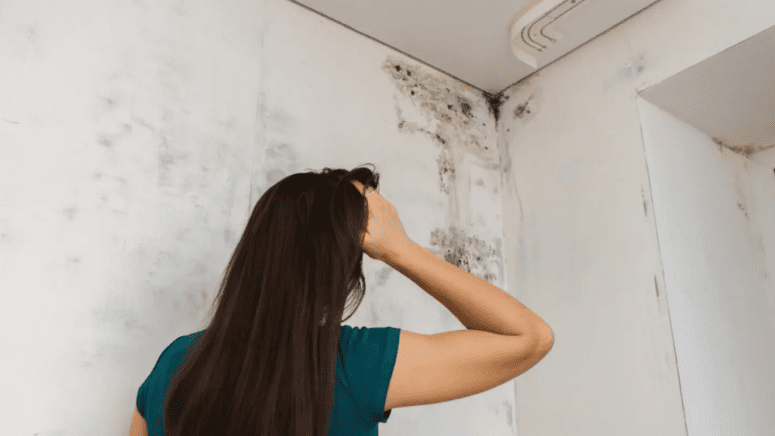8 Pro Tips for Selling a House with Mold Without Scaring Off Buyers
- Published on
- 6 min read
-
 Elizabeth Pandolfi, Contributing AuthorClose
Elizabeth Pandolfi, Contributing AuthorClose Elizabeth Pandolfi Contributing Author
Elizabeth Pandolfi Contributing AuthorElizabeth Pandolfi is an award-winning writer and editor with expertise in real estate coverage, including New Urban and planned communities.
-
 Fran Metz, Contributing EditorClose
Fran Metz, Contributing EditorClose Fran Metz Contributing Editor
Fran Metz Contributing EditorFran Metz is a freelance content writer, editor, blogger and traveler based in Las Vegas, Nevada. She has seven years of experience in print journalism, working at newspapers from coast to coast. She has a BA in Mass Communications from Fort Lewis College in Durango, Colorado, and lived in Arvada for 15 years, where she gained her experience with the ever-changing real estate market. In her free time, she enjoys 4-wheeling, fishing, and creating digital art.
When it comes to selling your home, mold is a major red flag you can’t afford to ignore. When selling a house with mold, even if the issue seems small, “It’s the kind of word that can make people perceive the house as stigmatized,” says Jim Geracie, a top-selling real estate agent in Brookfield, Wisconsin.
Buyers are immediately put off by visible mold, which not only detracts from the home’s appearance but may also raise concerns about its structural integrity and potential health risks like allergens or respiratory issues.
Ignoring mold can lead to a lower sale price or a string of buyers backing out due to concerns over the issue. To avoid this, it’s vital to tackle mold problems directly, ensuring every trace of it is addressed thoroughly. By following expert advice from mold remediation specialists and real estate professionals, you can increase your chances of securing the best price without scaring off prospective buyers.
By following these eight expert-backed tips from specialists in mold remediation and real estate, you can improve your chances of closing the deal without compromising your asking price. These strategies will help you address mold concerns head-on, restoring the value of your home while ensuring you attract serious, confident buyers.
1. Know when to get a mold inspection — or skip straight to remediation
HomeLight spoke with Jay Van Deusen, owner of Rainbow International of Northeastern Maryland, to shed light on the often misunderstood nature of mold. Van Deusen, an expert in mold removal and remediation, explained that mold is a “naturally occurring microscopic fungi,” and while it’s often perceived as a health hazard, it’s not always dangerous.
“The most common misconception about mold is that all mold is dangerous to you in any quantity or type,” Van Deusen says. “Mold is all around us and has been for centuries. It is part of the natural process that allows animals and plants and other natural materials to decay and be consumed.”
However, he notes that selling a house with mold can become problematic when it grows in the wrong conditions, particularly in large amounts or certain harmful varieties. In those cases, it’s crucial to eliminate the environmental factors that promote its growth and properly address the infestation.
There are many types of mold, but only three main classifications for them: pathogenic, allergenic, and toxigenic.
- Pathogenic: Can cause infections in people who have compromised immune systems.
- Allergenic: Unlikely to cause illness but can trigger allergies in people who are susceptible and cause symptoms for those with asthma.
- Toxigenic: Toxic to all humans and animals.
Mold can appear in various forms, from different sizes and shapes to a range of colors, including black, green, and white. While some types of mold are harmless, others can be toxic and pose serious health risks. It’s important to identify the type of mold present, as the conditions that allow it to thrive — and the potential hazards — differ significantly depending on the species. Mold remediation should be considered when toxic or problematic mold is found in your home.
The important takeaway is that if you can see visible mold in your home, a mold inspection is unnecessary. You already know the problem exists, so there’s no reason to spend time or money on an inspection, especially when selling a house with mold and you are up against a deadline. Instead, you can move directly to the remediation phase, whether that means tackling a small infestation yourself (for minor cases) or hiring a professional mold remediation company for more extensive issues. This approach saves both time and money, ensuring the problem is dealt with swiftly and effectively. Just be sure to assess the severity before deciding whether a DIY solution is appropriate or if professional help is needed.
Mold testing, which involves swabbing and identifying the specific strain, isn’t necessary if visible mold is present. The EPA advises against it, as there are no federal standards for mold types or spores. Regardless of the strain, mold removal is required. The focus should be on cleaning up the mold, not identifying its exact type, since all mold requires remediation to ensure a safe, healthy environment.
A mold inspection is a smart choice if you suspect mold due to a musty smell or recent water intrusion but can’t see any visible signs. The EPA cautions against using smell or allergic reactions as reliable indicators, as many people don’t react to mold. A more dependable sign of potential mold is recent water damage or plumbing leaks, since mold thrives in moist environments. If your home has experienced a roof leak, flooding in crawl spaces or basements, or pipe issues, mold is likely to follow.
If you’re aware of significant water damage, it’s wise to get a mold inspection before listing your home. Identifying mold early can prevent issues down the line and ensure your home is in top shape for prospective buyers.
2. Limit DIY mold cleanup to 10 sq ft — Call a pro for more
You’re gearing up to sell your home when you spot them: Those little black spots that creep up the wall behind your water heater, line your basement windowsill, or colonize the area behind your washing machine.
It might be tempting to tackle mold removal yourself to save money, but you should only attempt it if the affected area is smaller than 10 square feet. Anything larger can present serious health risks or require professional equipment and expertise. For bigger infestations, it’s best to call in a mold remediation specialist to ensure thorough and safe removal.
The do-it-yourself method involves a bleach mixture and small hand tools. There are also several ways to clean mold without harsh chemicals, including using vinegar, baking soda, and tea tree oil.
DIY mold cleanup may seem like a quick fix, but it’s typically not a long-term solution. While cleaning with bleach or a gentler solution can remove visible mold, it doesn’t eliminate the mold spores, which can continue to spread. Over time, the mold may build resistance to the cleaning agents, making it harder to remove and allowing the mold to thrive once it encounters moisture again.
Mold has a defensive reaction to being cleaned, explains Van Deusen, releasing spores into the air when disturbed. This can lead to cross-contamination, spreading the mold to previously unaffected areas. Professional remediation is necessary to fully address the problem by targeting both the mold growth and spores, preventing the mold from returning. Proper removal methods also reduce the risk of health complications from mold exposure.
Larger mold removal projects come with a significant risk of cross-contamination, making them unsuitable for DIY attempts. If mold is disturbed improperly, spores can spread to other areas, worsening the problem and potentially affecting more of the home. Moreover, removing mold, particularly from structural materials, is often a labor-intensive task that requires specialized knowledge and equipment to do safely.
Hiring a qualified professional for mold remediation ensures the job is done properly, protecting your home’s structural integrity. While it may seem costly upfront, professional remediation can actually save you money in the long run by preventing further damage and ensuring the mold is completely eliminated, minimizing the risk of future infestations.
If removed incorrectly, mold infestation can grow and become a very expensive project. Aside from the financial impact, the negative health effects increase significantly when cross-contamination occurs.
3. Don’t assume you’re in the clear until after inspection
Because mold often grows in attics and crawl spaces, if you don’t check those areas regularly, you may have no idea you have a mold problem until it shows up on the buyer’s home inspection report.
“Most of these things rear their ugly heads during the home inspection phase when someone is going into the attic or basement, or crawl space,” Geracie says. “A section will look blackened or darkened, and you can see that mold is starting to grow.”
If mold is detected, the buyer most likely will request remediation. In most cases, it’s wiser to fix the issue right away rather than argue over it. “At that point, we get someone who’s certified in mold remediation, and they do whatever it is they have to do,” Geracie says. “Because if we lose this buyer, the next buyer is going to ask for the same thing, and probably offer a lower price.”
4. Always disclose known mold issues to buyers
When selling a house with mold — no matter the size of your mold issue, whether it’s been remediated or not — always disclose it using the proper forms. Failing to disclose known mold problems can lead to consequences far more serious than a lost sale if the buyer uncovers the issue later.
“Disclose everything, because the reality is that a buyer will buy a home with problems if they know about them on the front end,” Geracie advises.
“If they find out after the fact and feel like they’ve been lied to, they usually like to talk about the lack of disclosure behind an attorney in court.”
This is one of the many reasons it’s important to use an experienced real estate agent. An agent’s guidance can help prevent any inadvertent lack of disclosure on the seller’s part, and ensure that any disclosures are made properly.
5. Document any mold found and the remediation steps taken
When it comes to disclosures when selling a house with mold, it’s in your best interest to document any issues you’re aware of, along with the steps you’ve taken to resolve them. This includes mold, just as it would a leaky roof or termite infestation.
Proper documentation could include:
- Photos of the mold infestation prior to any cleaning or remediation
- Written documentation of any steps you took yourself to clean it up (through using a bleach solution, for example)
- Reports and receipts from the mold remediation company you used
- Ongoing efforts to dry out the area, such as using a dehumidifier
Since each state has their own rules on disclosures, a real estate agent will be able to guide you through your state’s disclosure process and requirements. You can also find out what forms and documentation are needed by visiting your state’s Department of Real Estate website.
6. Choose a mold remediation company with proper certifications
Selling a house with mold becomes much simpler once you have certification from a reputable remediation contractor, so choose carefully. Don’t hesitate to ask about waste disposal methods, insurance coverage, work documentation, and their views on mold as a health hazard to get a clearer sense of the company’s qualifications. Van Deusen also emphasizes the importance of checking for proper credentials:
“Any remediation contractor should at minimum have IICRC (Institute of Inspection Cleaning and Restoration Certification) credentials,” Van Deusen says, adding that it’s important for the remediation expert to have environmental insurance coverage because it provides liability insurance in case contamination occurs during remediation.
Standard contractor liability insurance doesn’t cover environmental contamination, including mold. He also notes that most homeowner’s insurance policies exclude coverage for this type of contamination.
For guidance on finding a trustworthy remediation contractor, consult the Restoration Industry Association, a nonprofit organization committed to promoting best practices in the restoration industry.
7. Consider offering a credit for mold prevention services
If you don’t want to take the time to handle mold remediation yourself, another option is to credit the buyer for the cost of the remediation.
As top-performing Columbus, Ohio, agent Brandon Prewitt says repair credits can be a better way to handle repairs. “We want the buyer to know that the work will be done to their satisfaction, with a contractor they trust.”
Offering credits also can eliminate the risk of a buyer being unhappy with the mold remediation you arranged and paid for.
8. Prevent mold growth during closing
Even if you’re selling a home with a mold issue, it’s helpful to know how to prevent future problems and ensure no new issues arise before closing. Once the remediation is done, keeping the house dry and well-ventilated is your best defense. By using dehumidifiers, fans, and opening windows, you can greatly reduce moisture levels in the home.
Additionally, Van Deusen says it helps to ask how the mold started in the first place, to avoid repeat infestation.
“If you remove the SMG (suspected microbial growth) and you don’t remove or alter the conditions that allowed it to propagate, it will come back. Mold loves heat, humidity, and good food sources. Some of its favorite meals are wallpaper paste and the glue that holds drywall paper to the gypsum behind it. Add in the humidity over 60% and temperatures over 50 degrees, and it’s an SMG paradise,” he says.
Selling a home with mold can present challenges, but by taking the right steps to identify, remediate, and, most importantly, disclose the issue, you’ll set yourself up for a smoother closing process.
Header Image Source: (Burdun Iliya / Shutterstock)






